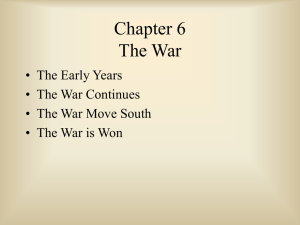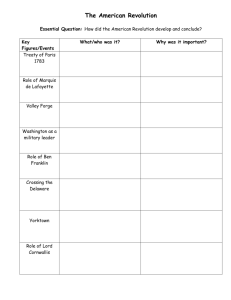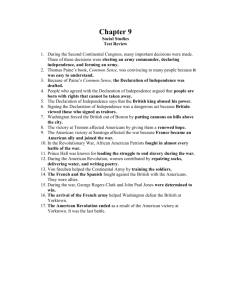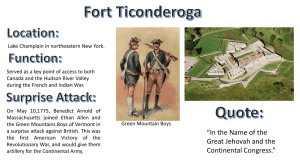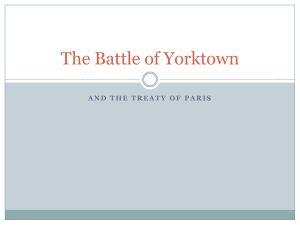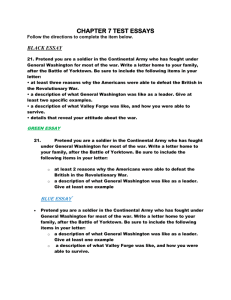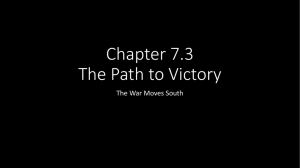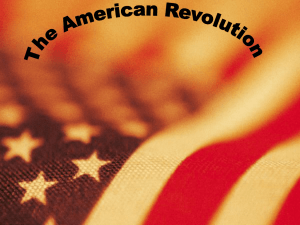AP US History
advertisement
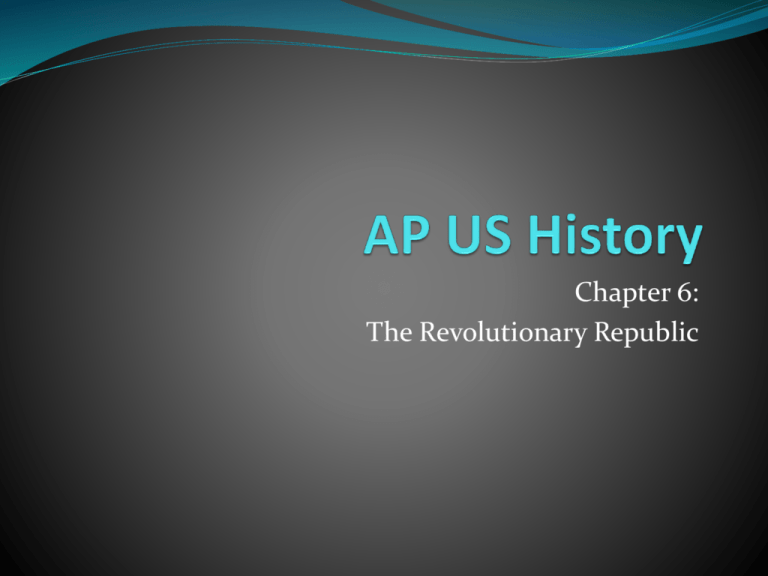
Chapter 6: The Revolutionary Republic The Northern War, 1776-77 The American success of 1775-76 did not last Fort Ticonderoga, May-July 1776 British ships sailed up St. Lawrence River, forcing the Americans to retreat to Lake Champlain, NY New York, September 1776 British General William Howe and Admiral Richard Howe amassed a huge garrison on Staten Island George Washington decided to split his force between Manhattan and Long Island, digging in at Brooklyn By December, Washington had abandoned New York City, and much of the surrounding area was also captured by the British Many felt the war was over as the Continental Army crossed the Delaware River into Pennsylvania Thousands of troops either abandoned or did not reenlist Trenton and Princeton Washington had to do something to turn the tide of the war Troops refusing to reenlist Troop morale very low Bold action by Washington on December 25, 1776 boosted morale Surprised a Hessian garrison at Trenton Crossed the Delaware River by night, taking over 1000 prisoners Outwitted British General William Cornwallis on January 2, 1777 at Princeton Snuck away at night and moved north away from the British garrison British troops marching from Princeton to Trenton were surprised again, giving the Continentals two victories in a week Boosted troop morale and slightly increased reenlistments Loyalists began coming over to the American cause Struggles and Successes of 1777 Fort Ticonderoga was taken by the British in May 1777 The Continental capitol of Philadelphia was taken by the British in September Losses at Brandywine Creek and Germantown forced Washington to seek help Baron von Steuben and Frederich Wilhelm, two Germans, Marquis de Lafayette, a Frenchman, and other professional soldiers from Europe came to his help Instilled a training regimen to make the military more professional and disciplined Holed up at Valley Forge, near Philadelphia, for the winter of 1777-78 However, the turning point of the war came in October 1777 at Saratoga, NY, near Fort Ticonderoga British General Burgoyne was continuously hounded and cut off from supplies, finally surrendering on October 17 The American victory convinced the French to formally recognize the United States, to which two treaties were signed in 1778 Also brought Spain, informally, into the war ©2004 Wadsworth, a division of Thomson Learning, Inc. Thomson Learning™ is a trademark used herein under license. War for Independence 1776-1777 Revolutionary Crisis Loyalists, or Tories, hampered colonial, or patriot, progress Slaves often times backed the British Many slaves fled bondage during the war Thousands left the United States for other parts of the British Empire afterward While neutral in the beginning, the Native American tribes of the colonies sided with the British By 1779-1780, Army morale was so low, the Army was nearing collapse The British Southern Offensive In 1780, the British launched a very successful offensive to take the Deep South Started with the taking of Savannah, GA Both Carolinas were also taken very quickly However, the colonists were able to hold their own General Nathanael Greene of the Continental Army ravaged the British forces By 1781, only Savannah and Charleston, SC were held by the British Greene retreated his forces into Virginia British General Cornwallis followed Set up the final battle at Yorktown, starting in August 1781 Yorktown While Greene lured Cornwallis to Virginia, the rest of the Continental Army was preparing The French Navy defeated the British Navy off the coast of Virginia, blocking escape by sea George Washington was marching reinforcements from New York Cornwallis, needing supplies, marched his forces onto a small peninsula at Yorktown Not aware of the defeat at sea or the Continental advances Surrounded and beseiged, Cornwallis surrendered his army on October 19, 1781 Yorktown brought down the British government in early 1782 and led to the Treaty of Paris in 1783 Recognized American independence Mississippi River western boundary Gave America rights to fishing waters off of Newfoundland ©2004 Wadsworth, a division of Thomson Learning, Inc. Thomson Learning ™ is a trademark used herein under license. Yorktown Campaign, 1781 The New Nation Several changes took place after the end of the war Articles of Confederation National government, giving power to the states Very weak, eventually failed Virginia Statute for Religious Freedom, 1786 Guaranteed freedom of religion, basis for Bill of Rights States, especially in the North, began to enact emancipation laws PA first in 1780 South continued to use slave labor Atlantic slave trade outlawed in 1808 Lands west of the Appalachians settled more and more Kentucky and Tennessee especially popular Made possible by Daniel Boone and his group that opened up a trail through the Cumberland Gap The New Nation Land Ordinance of 1785 Outlined rules for the Northwest Territories, the eventual states of Ohio, Indiana, Illinois, Michigan, Wisconsin and Minnesota Divided land into areas 6 miles square called townships Defined rules for sale of land at auction Northwest Ordinance of 1787 Organized settlement in the territories Agreed to divided into 2-5 states Required a school for every township Outlawed slavery Established rules on how territories would become states Northwest Territory, 1787 The Failing Union The United States struggled mightily in the years following the war Articles of Confederation had several weaknesses No power to tax or regulate commerce Could not regulate foreign relations Could not raise an army Debt from the war was enormous Shays’ Rebellion in 1786 proved that something needed to be done Daniel Shays, a Revolution veteran, led a group of protestors against judges and debt collectors that were foreclosing homes and farms The rebellion was eventually put down, but the government had a hard time rallying a militia to end it Representatives from several states agreed to meet in May 1787 to fix the Articles The Constitutional Convention Convention opened in May 1787 in Philadelphia George Washington elected president of the convention James Madison recorded all actions of the months long convention Addressed several concerns, often in very heated discussions that almost ended the convention Proposed several plans for a new government Virginia Plan: representation based on population, bicameral legislature New Jersey Plan: representation based equality and the power to tax and regulate commerce Connecticut Compromise: combination of both plans, with a bicameral legislature House of Representatives: population based representation Senate: two senators per state, regardless of size Approved and sent to the states for ratification on September 17, 1787 Federalists v. Anti-Federalists Two distinct groups formed after initial approval Federalists: for ratification of the Constitution Anti-Federalists: against ratification, feeling it gave too much power to the government and lacked a Bill of Rights Federalists wrote a series of essays, the Federalist Papers, justifying the cause Insisted that checks and balances would prevent tyranny between the president, Congress, and courts Promised to add a Bill of Rights upon ratification Eventually, enough states ratified, allowing for the first Congress to meet in 1789 Rhode Island and North Carolina, holdouts of ratification, eventually ratified as well The Bill of Rights was debated and ratified in 1789 as well For Further Information… http://www.usconstitution.net/constconart.html http://www.archives.gov/exhibits/charters/constitution.html http://www.archives.gov/exhibits/charters/bill_of_rights.htm l http://www.loc.gov/rr/program/bib/ourdocs/Constitution.ht ml Copy and paste these links into your browser for more information on the Constitution, Bill of Rights, and a comparison of the Constitution to the Articles of Confederation

